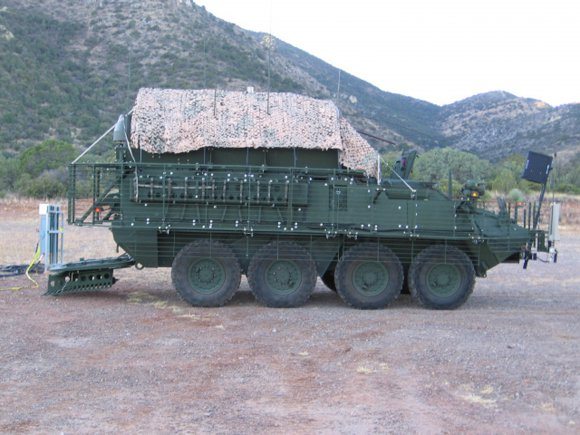To increase the accuracy and speed of decisions made on the most critical points of the battlefield, the Army is providing Soldiers with the same mission command capabilities in a mobile platform that they have at their home base.
“With Mission Command On the Move we are transitioning from having Soldiers be tethered to their Tactical Operations Centers in order to receive the common operating picture to enabling them to place themselves at the most critical points on the battlefield while still leveraging all of the same mission command capabilities,” said Lt. Col. Carl J. Hollister, product manager for Command Post Systems and Integration.
In support of theater-generated Operational Needs Statements, or ONS, product manager for Command Post Systems and Integration, known as PdM CPS&I, which is assigned to Project Manager Warfighter Information Network-Tactical, or PM WIN-T, has provided MCOTM capabilities to Afghanistan and Iraq. The ONS process allows urgent requests from theater for equipment or resources to be identified and rapidly fielded.
Nine Caiman mine-resistant, ambush-protected, or MRAP, platforms were provided in support of ONS in Iraq this year and four Stryker platforms were deployed to Afghanistan in support of an ONS generated by one of the Stryker brigades.
“Mission Command On the Move provides Soldiers with many of the same capabilities resident in the fixed command post, as well as the necessary wideband throughput enabling them to execute the art of battle command on-the-move or at-the-quick-halt from any vantage point,” said Lt. Col. Terry Wilson, former PdM for CPS&I. Wilson has since taken the position as Research, Development and Engineering Command III Corps’ Science and Technology Officer.
MCOTM — a mission command equipment package — is integrated into Bradley, Stryker and MRAP platforms. It enables the Soldier to be present at the decisive point on the battlefield, provides the relevant Common Operational Picture, or COP, and enables situational awareness while on-the-move. It is designed to support mobile mission command requirements for corps, division and brigade level, but more recently it has been pushed down to the battalion level.
MCOTM provides both line-of-sight (terrestrial) and beyond-line-of-sight (satellite) communications, which means that in places like Afghanistan where the terrain doesn’t always support terrestrial communications, the Soldiers will not lose critical capabilities.
“In high-intensity conflicts, Mission Command On The Move will allow the Soldier to stay ahead of the enemy because he is receiving and pushing out information faster and with greater accuracy,” said Maj. Michael Williams, assistant PdM for MCOTM.
The CPS&I team has actually recreated the way the Army fields mobile mission command. Back in 2008, two weeks after the product office had been awarded Mobile Battle Command On-The-Move, or MBCOTM, the Army terminated the program, but the requirement to provide that capability to Soldiers still remained, Wilson said.
PdM CPS&I has been able to transition the old MBCOTM program so that it executes the new Mission Command On The Move, or MCOTM, systems through the ONS process. When the ONS inevitably started to come through, the team utilized the lessons-learned from the previous program to fill the requirements in an efficient, cost effective manner. The team was able to utilize the work of other organizations to build the needed integrated mobile mission command capabilities, Wilson said.
“Because we were able to achieve this level of integration and reliability, those platforms are in theatre right now and have recently received accolades from ATEC (Army Test and Evaluation Command) Operational Assessment,” Wilson said. “It has been a real success story.”
The fielding of the four MCOTM Stryker platforms in Afghanistan began as an ONS for a single mission command vehicle, but PdM CPS&I was able to leverage preexisting assets and provide four platforms for a more complete response. Until this particular effort, the organization had only provided these capabilities to brigade and above echelons, but for the first time the mission command platform was pushed down to the battalion level.
In Iraq’s Operation New Dawn, the MCOTM platforms are being used to assist in the drawdown efforts. As forward operating bases, or FOBs, are in the process of shutting down, the platforms are being used to fill the gap in communication assets, running operations while the TOCs are being disassembled.
“It’s the last vehicle at the FOB, and once the FOB closes, they just drive it right out,” Williams said.
MCOTM will also supply needed freedom of maneuver in high-tempo operations without losing mission command capabilities in transit.
“MCOTM will provide the Soldier the ability to leverage all of his mission command capabilities resident in his TOC,” Williams said.
The versatility of MCOTM enables full spectrum operations from Tier One operations (stability and support) all the way up to Tier Three (high intensity conflicts) without ever having to set up a TOC.
“Instead of having to receive Command Post Of the Future updates from the FOB, the Soldier can be out on the battlefield circulating around and if a critical mission comes up, he can easily receive it on his CPOF, for example, or whatever system he wants to use,” Williams said. “Then he can approve, disapprove, or modify it, or just simply monitor what is going on.”
Currently there are nine MCOTM packages fielded in Iraq, four in Afghanistan, and four High Mobility Multipurpose Wheeled Vehicle trainers and one Stryker trainer at Fort Hood, Texas. The trainers are shipped to various points in the United States to prepare units deploying into theater.
MCOTM platforms leverage the Army’s WIN-T Increment 1 network and will eventually integrate with the WIN-T Increment 2, which is expected to reach the first unit in 2012. WIN-T Increment 2 will provide the initial on-the-move network communications from division down to the company level.
“The Soldier on-the-move is getting more accurate information,” Hollister said. “He is not relying on someone to translate a map or the common operating picture just using a radio. He can see exactly what his chief of staff can see back at the Tactical Operations Center. That is invaluable.”










